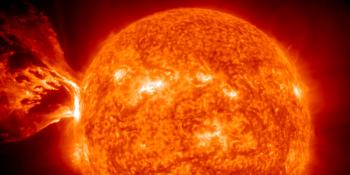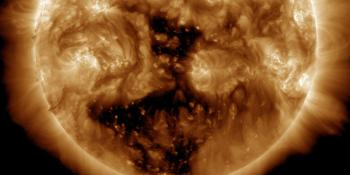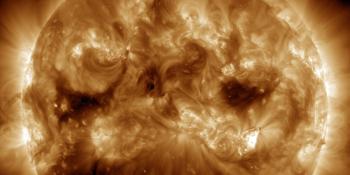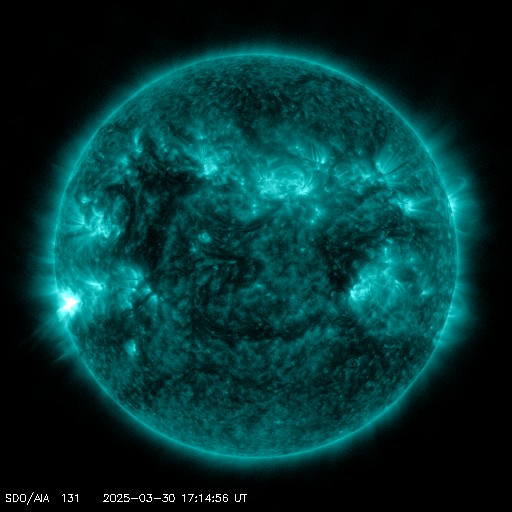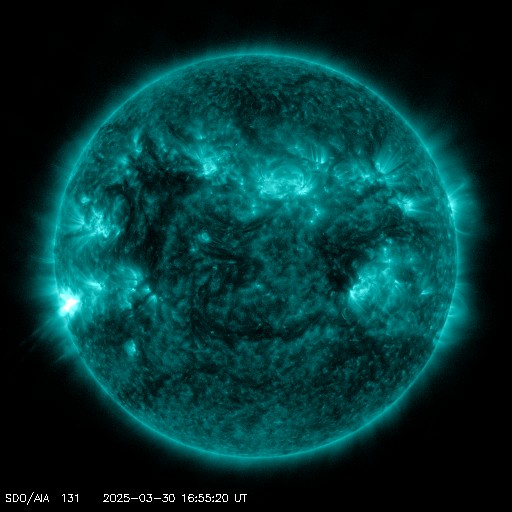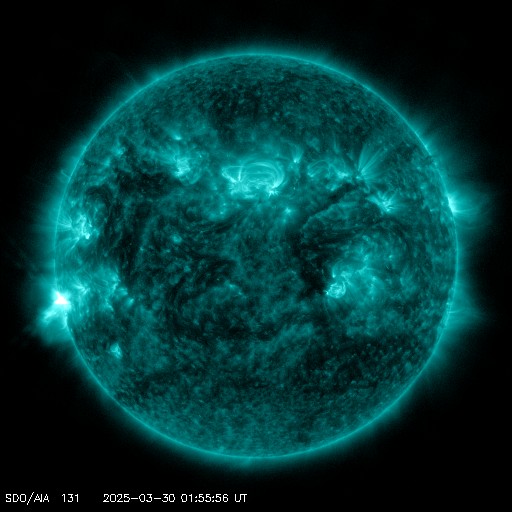Viewing archive of Monday, 20 May 2002
Solar activity report
Any mentioned solar flare in this report has a scaling factor applied by the Space Weather Prediction Center (SWPC). Because of the SWPC scaling factor, solar flares are reported as 42% smaller than for the science quality data. The scaling factor has been removed from our archived solar flare data to reflect the true physical units.
Report of Solar-Geophysical Activity 2002 May 20 2200 UTCPrepared by the NOAA © SWPC and processed by SpaceWeatherLive.com
Joint USAF/NOAA Report of Solar and Geophysical Activity
SDF Number 140 Issued at 2200Z on 20 May 2002IA. Analysis of Solar Active Regions and Activity from 19-2100Z to 20-2100Z
Solar activity was high. Region 9961 (S22E62) produced
two M-class flares and one X-class flare during the past 24 hours.
The X-flare was an X2/2n at 1527 UTC and was impulsive. Nonetheless
this flare was associated with a narrow-width CME from the southeast
limb. The first M-flare was an M4 at 1029 UTC and the second was an
M5 at 1053 UTC. Both of these events were impulsive and were
attributed to 9961 based on SOHO/EIT data. Region 9961 appears to be
a compact, magnetically complex group which has at least a gamma
classification, and possibly a magnetic delta. Region 9957 (N09E22)
continues to be the largest group on the disk and has a delta
configuration in a compact collection of spots. A partial halo CME
was observed in C2 at 19/2026 UTC and was centered over the
southwest limb. EIT images at the same time confirmed a front-side
source from the southwest part of the disk.
IB. Solar Activity Forecast
Solar activity is expected to be
mostly moderate, but there is a chance for an additional major flare
event from either of Region 9961 or 9957.
IIA. Geophysical Activity Summary 19-2100Z to 20-2100Z
The geomagnetic field was mostly quiet to unsettled during the past
24 hours. There was an isolated active period from 1500-1800 UTC. An
interval of enhanced solar wind flow passed the ACE solar wind
spacecraft beginning at 0257 UTC and lasted about 10 hours. The Bz
magnetic field component was mostly negative with typical values
between -5 nT and -10 nT. The onset of the this flow at Earth caused
a sudden impulse at 0342 UTC, which measured 22 nT on the Boulder
magnetometer.
IIB. Geophysical Activity Forecast
The geomagnetic field should be
mostly unsettled tomorrow and quiet to unsettled on the second day.
Activity on the third day is expected increase slightly to unsettled
with some isolated active periods due to possible effects from
today's partial halo CME that began at 19/2026 UTC.
III. Event Probabilities 21 May to 23 May
| Class M | 80% | 80% | 80% |
| Class X | 20% | 20% | 20% |
| Proton | 15% | 15% | 15% |
| PCAF | green | ||
IV. Penticton 10.7 cm Flux
Observed 20 May 171 Predicted 21 May-23 May 170/170/165 90 Day Mean 20 May 184
V. Geomagnetic A Indices
Observed Afr/Ap 19 May 008/018 Estimated Afr/Ap 20 May 010/015 Predicted Afr/Ap 21 May-23 May 008/010-005/008-012/015
VI. Geomagnetic Activity Probabilities 21 May to 23 May
| A. Middle Latitudes | |||
|---|---|---|---|
| Active | 20% | 20% | 25% |
| Minor storm | 10% | 10% | 15% |
| Major-severe storm | 05% | 05% | 10% |
| B. High Latitudes | |||
|---|---|---|---|
| Active | 20% | 20% | 25% |
| Minor storm | 10% | 10% | 20% |
| Major-severe storm | 05% | 05% | 15% |
All times in UTC
Current data suggests there is a slight possibility for aurora to appear at the following high latitude regions in the near future
Oulu, Rovaniemi, Sodankylä, UtsjokiKirkenes
Murmansk, Vorkuta
Kiruna, Luleå
Latest news
Latest forum messages
More topicsSupport SpaceWeatherLive.com!
A lot of people come to SpaceWeatherLive to follow the Sun's activity or if there is aurora to be seen, but with more traffic comes higher server costs. Consider a donation if you enjoy SpaceWeatherLive so we can keep the website online!

Latest alerts
17:27 UTC - Solar flare
Moderate M1.5 flare
17:03 UTC - Solar flare
Moderate M1.61 flare
16:45 UTC - Radio Blackout
Minor R1 radio blackout in progress (≥M1 - current: M1.61)
02:09 UTC - Solar flare
Moderate M1.54 flare from sunspot region 4048
01:42 UTC - Radio Blackout
Minor R1 radio blackout in progress (≥M1 - current: M1.24)
Space weather facts
| Last X-flare | 2025/03/28 | X1.1 |
| Last M-flare | 2025/03/30 | M1.4 |
| Last geomagnetic storm | 2025/03/27 | Kp5 (G1) |
| Spotless days | |
|---|---|
| Last spotless day | 2022/06/08 |
| Monthly mean Sunspot Number | |
|---|---|
| February 2025 | 154.6 +17.6 |
| March 2025 | 127.5 -27.1 |
| Last 30 days | 127.5 -24.7 |
